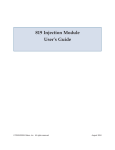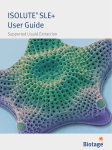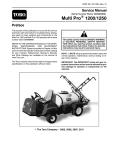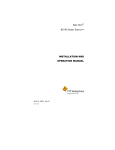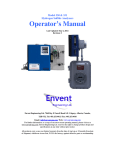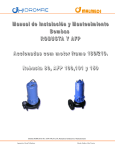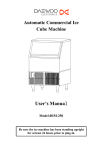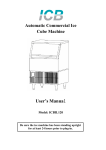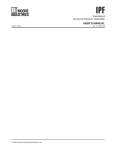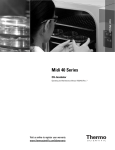Download Siemens CA 333 Series Specifications
Transcript
Siemens Industry, Inc. INSTALLATION AND SERVICE INSTRUCTION SD74 Rev. 19 January 2011 Supersedes Issue 18 Model Series 74 Valve Positioner and Motion Transmitter SD74 TABLE OF CONTENTS SECTION AND TITLE PAGE 1.0 INTRODUCTION .................................................................................................................................................4 1.1 MODEL DESIGNATION...................................................................................................................................4 1.2 SPECIFICATIONS .............................................................................................................................................4 1.3 ORDERING RANGE AND SUPPRESSION SPRING KITS............................................................................5 1.4 CUSTOMER/PRODUCT SUPPORT .................................................................................................................7 2.0 INSTALLATION ..................................................................................................................................................8 2.1 PNEUMATIC CONNECTIONS.........................................................................................................................8 2.2 INSTRUMENT AIR REQUIREMENTS............................................................................................................8 2.3 VALVE POSITIONER .......................................................................................................................................9 2.4 MOTION TRANSMITTER ................................................................................................................................9 2.5 RANGE AND SUPPRESSION SPRING KITS ...............................................................................................12 2.5.1 Rectilinear Range Spring Kit......................................................................................................................12 2.5.2 Rotary Range Spring Kit ............................................................................................................................12 2.5.3 Suppression Spring Kit...............................................................................................................................14 3.0 CALIBRATION ..................................................................................................................................................15 3.1 VALVE POSITIONER .....................................................................................................................................15 3.1.1 Rectilinear Range Spring............................................................................................................................15 3.1.2 Rotary Range Spring ..................................................................................................................................15 3.2 OUTPUT PRESSURE LEVEL ADJUSTMENT..............................................................................................15 3.3 MOTION TRANSMITTER ..............................................................................................................................16 4.0 OPERATION.......................................................................................................................................................17 4.1 VALVE POSITIONER .....................................................................................................................................17 4.2 MOTION TRANSMITTER ..............................................................................................................................18 5.0 MAINTENANCE ................................................................................................................................................19 5.1 DISASSEMBLY ...............................................................................................................................................21 5.2 ASSEMBLY......................................................................................................................................................22 5.3 PREVENTIVE ..................................................................................................................................................22 6.0 PARTS LIST........................................................................................................................................................23 2 SD74 LIST OF ILLUSTRATIONS FIGURE AND TITLE 2-1 2-3 2-4 2-5 4-1 4-2 5-1 5-2 5-3 PAGE Installation Dimensions........................................................................................................................................10 Rotary Range Spring Kit Assembly and Parts List ..............................................................................................13 Rotary Range Spring Assembly ...........................................................................................................................13 Mounting Plate .....................................................................................................................................................14 Valve Positioner Schematic .................................................................................................................................18 Motion Transmitter Schematic.............................................................................................................................19 Parts Comparison Models 74 and 74S .................................................................................................................20 Upper Housing and Output Diaphragm ...............................................................................................................21 Diaphragm and Beam Assembly..........................................................................................................................22 LIST OF TABLESS TABLE AND TITLE 1-1 1-2 1-3 2-1 2-2 PAGE Rectilinear Range Spring Kits................................................................................................................................5 Rotary Range Spring Kits ......................................................................................................................................6 Zero Suppression Spring Kits ................................................................................................................................6 Double-Acting Cylinder Operators ......................................................................................................................11 Single-Acting Operators.......................................................................................................................................11 Changes for Revision 19, January 2011 Significant changes for this revision are indicated by change bars in the outside page margins. Some of these changes are listed below. CHANGE Cover banner updated; manual revision number and date changed. Section 1.4 Customer/Product Support updated. In Section 2.4, volume chamber part number deleted. Warranty statements revised and moved to Section 1.4. All product designations may be trademarks or product names of Siemens Industry, Inc. or other supplier companies whose use by third parties for their own purposes could violate the rights of the owners. Siemens Industry, Inc. assumes no liability for errors or omissions in this document or for the application and use of information in this document. The information herein is subject to change without notice. Procedures in this document have been reviewed for compliance with applicable approval agency requirements and are considered sound practice. Neither Siemens Industry, Inc. nor these agencies are responsible for product uses not included in the approval certification(s) or for repairs or modifications made by the user. 3 SD74 1.0 INTRODUCTION This instruction describes the installation, operation, and maintenance of the Model Series 74 Valve Positioner and Motion Transmitter. The Model Series 74 is a two-stage, high frequency response valve positioner. The positioner incorporates dual outputs which makes it ideally suited for double-acting cylinder operators. When one output is supplying air, the other is exhausting it. This action provides large differential forces to drive the actuator to the desired position. The Model Series 74 is also used as a single-acting positioner for spring type and cushion-load actuators. In this case, only one positioner output is used. The Model 74S can be used as a motion transmitter. It delivers a 3-15 psig output for input motion spans from 1/4" to 48". For this application, a stabilizing restriction is added to the positioner piping. Normally the Model 74S is used on small-bore cylinder operators of limited volume (generally 4" I.D. and smaller). IMPORTANT Save this Instruction and make it available for installation and maintenance of the instrument. 1.1 MODEL DESIGNATION Sample Model Number 74 S G – 1 Basic Model Number S – with Stabilizing Pilot and Reduced Gain Blank – Standard Positioner G – with (3) Gauges N – without Gauges With Standard Pilot and Reduced Gain 1.2 SPECIFICATIONS Input Ranges................................................................3-15, 3-9, 3-27, 0-15 and 0-30 including split ranges within these basic ranges Valve Stroke, Rectilinear Range Spring Minimum ..............................................................1/4" Maximum .............................................................48" Valve Stroke, Rotary Range Spring ............................90° travel CW or CCW Supply Pressure Minimum ..............................................................3 psi above full actuator pressure required Maximum .............................................................150 psig Ambient Temperature Limits ......................................-40°C to +82°C (-40°F to +180°F) The Model Series 74 has been designed and manufactured in accordance with Article 3, Paragraph 3 of Pressure Equipment Directive 97/23/EC. 4 SD74 1.3 ORDERING RANGE AND SUPPRESSION SPRING KITS Order either a rectilinear spring kit or a rotary spring kit for each Model 74, depending upon the intended actuator. • For a rectilinear actuator, refer to Table 1-1 and, considering actuator stroke length and Model 74 input pressure range, select the needed kit. • For a rotary actuator, refer to Table 1-2 and, considering actuator direction of stem rotation and Model 74 input pressure range, select the needed kit. For split ranges, also order a zero suppression kit from Table 1-3. Section 2 Installation contains illustrations of most Model 74 parts including those in the kits mentioned here. TABLE 1-1 Rectilinear Range Spring Kits Figures 2-1 and 2-2 show the rectilinear range spring. ACTUATOR STROKE IN INCHES 1/4 to 1-1/2 1-1/2 to 2-3/4 2-3/4 to 4 4 to 6 6 to 9 9 to 12 12 to 19 19 to 36 KIT AND PARTS Kit No. Spring No. Color Code Screw No. Kit No. Spring No. Color Code Screw No. Kit No. Spring No. Color Code Screw No. Kit No. Spring No. Color Code Screw No. Kit No. Spring No. Color Code Screw No. Kit No. Spring No. Color Code Screw No. Kit No. Spring No. Color Code Screw No. Kit No. Spring No. Color Code Screw No. INSTRUMENT INPUT PRESSURE RANGE IN PSIG 3-15 3-9 3-27 0-30 0-15 14995-101 14996-1 Black 12372-274 14995-102 14996-2 White 12372-273 14995-103 14996-3 Blue 12372-273 14995-119 14996-102 Brown 12372-292 14995-117 14996-104 Green 12372-292 14995-120 14996-106 Red 12372-303 14995-118 14996-110 Orange 12372-303 14997-1 14996-111 1 None 12372-303 14995-114 14996-4 Black-Red 12372-274 14995-115 14996-5 White-Red 12372-273 14995-116 14996-6 Blue-Red 12372-273 14995-104 14996-7 Black-Yellow 12372-274 14995-105 14996-8 White-Yellow 12372-273 14995-106 14996-9 Blue-Yellow 12372-273 149995-107 14996-10 Black-Orange 12372-274 14995-108 14996-11 White-Orange 12372-274 14995-109 14996-12 Blue-Orange 12372-292 14995-110 14996-13 Black-Green 12372-274 14995-111 14996-14 White-Green 12372-274 14995-112 14996-15 Blue-Green 12372-273 Not Available 14995-128 14996-16 Brown-Red 12372-303 14995-129 14996-17 Yellow-Red 12372-303 14995-126 14996-107 Green-Yellow 12372-303 14995-127 14996-108 Green-Red 12372-303 Not Available Not Available Not Available Not Available Continued on next page 1 Spring is factory cut for customer specified stroke. 5 SD74 TABLE 1-1 Rectilinear Range Spring Kits, Continued ACTUATOR STROKE IN INCHES 36-48 48 INSTRUMENT INPUT PRESSURE RANGE IN PSIG KIT AND PARTS Kit No. Spring No. Color Code Screw No. Kit No. Spring No. Color Code Screw No. 3-15 3-9 3-27 14997-1 14996-111 2 None 12372-296 14995-121 14996-1112 None 12372-296 0-30 0-15 Not Available Not Available TABLE 1-2 Rotary Range Spring Kits See Figure 2-3 for an exploded view of the kit and a parts list. A detailed view of the spring assembly appears in Figure 2-4. See Figure 2-5 for mounting plate dimensions. MOUNTING PLATE SUPPLIED Kit Without Mounting Plate Kit With Mounting Plate ROTATION OF ACTUATOR SHAFT Instrument Input Range in psig Kit No. Spring Assy. No. Color Code Kit No. Spring Assy. No. Color Code Mounting Plate CLOCKWISE COUNTERCLOCKWISE 3-9 3-15 3-9 3-15 14923-152 14923-72 Green 14923-151 14923-72 Green 14923-52 14923-154 14923-70 White 14923-153 14923-70 White 14923-52 14923-102 14923-73 Black 14923-101 14923-73 Black 14923-52 144923-104 14923-71 Red 14923-103 14923-71 Red 14923-52 TABLE 1-3 Zero Suppression Spring Kits Zero suppression spring kits include a suppression spring and a spring seat. All kits include the P/N 12372-254 spring seat (not listed below). See Figure 2-6. The zero suppression spring affects only the zero level by the fixed amount shown and has no effect on stroke or span. SUPPRESSION IN PSIG 2.5 6 9 11 12 14 2 ORDER KIT NO. 12517-201 12517-202 12517-208 12517-204 12517-205 12517-206 INCLUDES SPRING NO. 12497-1 12497-2 12497-8 12497-4 12497-5 12497-6 Spring is factory cut for customer specified stroke. 6 SPRING COLOR CODE Black Orange Brown Red Green White SD74 1.4 CUSTOMER/PRODUCT SUPPORT For support and the location of your local Siemens representative, refer to the table below for the URL of the Process Instrumentation (PI) portion of the Siemens public Internet site. Once at the site, click Support in the right column and then Product Support. Next select the type of support desired: sales, technical (see the table below), documentation, or software. Online Support Request http://www.siemens.com/automation/support-request Technical Support 1-800-333-7421; 8 a.m. to 4:45 p.m. eastern time, Monday through Friday (except holidays) Customer Service & Returns 1-800-365-8766 (warranty and non-warranty) Public Internet Site http://www.usa.siemens.com/pi Technical Publications in PDF Click the above link to go to the PI home page. Click Support and then Manuals and then, under “Additional Manuals,” select the product line (e.g. Control Solutions) Warranty The sales contract contains the entire obligation of Siemens. The warranty contained in the contract between the parties is the sole warranty of Siemens. Any statements continued herein do not create new warranties or modify the existing warranty. 7 SD74 2.0 INSTALLATION See Figure 2-1 for mounting dimensions and connections. The two basic mounting positions of the positioner are normal, where the nameplate is on the bottom, and inverted, where the nameplate is on top. Valve design and desired valve position when the input is at maximum determine whether the positioner should be mounted normal or inverted. Table 2-1 shows various positioner-actuator combinations when using a double-acting cylinder operator. Table 2-2 shows various positioner-actuator combinations when using a single-acting spring-loaded or cushionloaded actuator. In both the single-acting and double-acting combinations, a fail-safe action is provided. CAUTION Exceeding the specified ambient temperature limits can adversely affect performance and may cause damage. 2.1 PNEUMATIC CONNECTIONS All connections are 1/4" N.P.T. except the gauge connections, which are 1/8" N.P.T. The recommended piping for the positioner is 1/4" O.D. tubing, although any scale-free piping may be used. When making pneumatic connections: 1. Blow out all piping before making connections to prevent dirt, chips, etc., from entering the positioner. 2. Use pipe sealant sparingly, and only on the male threads. A non-hardening sealant is strongly recommended. 3. Connect the positioner to a source of clean, dry, oil-free instrument air. See Instrument Air Requirements below. CAUTION Pressure in excess of 150 psig to any connection may cause damage. 2.2 INSTRUMENT AIR REQUIREMENTS Connect the instrument to a source of clean, dry, oil-free instrument air. Failure to do so will increase the possibility of a malfunction or deviation from specified performance. CAUTION Use of process fluids other than instrument air is not recommended. No claim is made as to the suitability of this product for use with other process fluids, such as hazardous gases, except as listed on the appropriate certificate. Non-approved instruments are suitable for use with instrument air only. Optional features and modifications such as tapped exhaust do not imply suitability for use with hazardous gases except as listed on the approval certificate. There are many types of synthetic compressor lubricants. Some may not be compatible with the materials used in construction of the instrument. Wetting of these materials by such an oil mist or vapor, etc., may cause them to deteriorate. This may ultimately result in failure of the positioner. The following materials are in contact with instrument air: aluminum, brass, Buna-N, and stainless steel. 8 SD74 CAUTION Synthetic compressor lubricants in the air stream at the instrument may cause it to fail. The requirements for a quality instrument air supply can be found in the Instrument Society of America's "Quality Standard for Instrument Air" (ISA-S7.3). Basically, this standard calls for the following: Particle Size — Maximum particle size in the air stream at the instrument should be no larger than 3 microns. Dew Point — The dew point, at line pressure, should be at least 10°C (18°F) below the minimum temperature to which any part of the instrument air system is exposed at any season of the year. Under no circumstances should the dew point, at line pressure, exceed 2°C (35.6°F). Oil Content — Maximum total oil or hydrocarbon content, exclusive of non-condensable, should not exceed 1 ppm under normal operating conditions. 2.3 VALVE POSITIONER Single-Acting When used as a single-acting valve positioner, the Model 74 uses one output connection. If the VALVE 2 connection is used, an increase in output must increase range spring (feedback) tension. If the VALVE 1 connection is used, an increase in output must decrease range spring (feedback) tension. In either case, the connection not chosen must be plugged. Double-Acting When used as a double-acting valve positioner, the Model 74 uses both the VALVE 1 and VALVE 2 connections. In this case, an increase in output must increase range spring (feedback) tension. 2.4 MOTION TRANSMITTER When used as a motion transmitter, the VALVE 1 connection is the transmitter output; plug the VALVE 2 connection. To use the Model 74S as a motion transmitter, order the P/N 14411-7 restriction fitting and install as shown in Figure 4-2. For input motions greater than 12" and an output line that is less than 50 feet, install a volume chamber in the output line to insure stable operation. 9 SD74 6 PSI INSTR. PRESS. SPAN. 12 PSI INSTR. PRESS. SPAN 15 PSI INSTR. PRESS. SPAN 24 PSI INSTR. PRESS. SPAN 30 PSI INSTR. PRESS. SPAN Stroke “C” Dim. Stroke “C” Dim. Stroke “C” Dim. Stroke “C” Dim. Stroke “C” Dim. 1/4 to 1-1/2 1-1/2 1/4 to 1-1/2 1-5/16 1/4 to 1-1/2 1-9/32 1/4 to 1-1/2 1-17/32 1/4 to 1-1/2 1-19/32 1-1/2 to 2-3/4 2-9/32 1-1/2 to 2-3/4 2-7/32 1-1/2 to 2-3/4 2-7/32 1-1/2 to 2-3/4 2-9/32 1-1/2 to 2-3/4 2-9/32 2-3/4 to 4 3-9/32 2-3/4 to 4 3-7/32 2-3/4 to 4 3-5/32 2-3/4 to 4 3-1/4 2-3/4 to 4 3-5/32 4 to 6 4-1/2 6 to 9 5-31/32 6 to 9 5-3/4 6 to 9 7-1/2 9 to 12 7-23/32 9 to 12 8-9/16 9 to 12 9-5/8 12 to 19 12-1/32 19 to 37 * 37-48 * 48 * All dimensions in inches. * Calculate as shown below. “C” Dimension for strokes 19" or longer, with 3-15 psi instrument pressure range = 0.68 x stroke. Example: 19" stroke, C = 0.68 x 19 = 12.92" Notes: 1) All connections 1/4 NPT with exception of 1/8 NPT gauge connections. 2) Increase in instrument air causes increase in pressure at “Valve 2” connection. “Valve 2" pressure must be applied to actuator so as to extend range spring and restore balance. FIGURE 2-1 Installation Dimensions 10 SD74 TABLE 2-1 Double-Acting Cylinder Operators VALVE DESIGN Valve Action Down to Close Up to Close Down to Close Up to Close Maximum Controller Output, Valve Closes Opens Opens Closes For Controller Air Failure, Valve Opens Closes Closes Opens Positioner Mounting Inverted Inverted Normal Normal TABLE 2-2 Single-Acting Operators VALVE DESIGN Actuator Top Top Bottom Bottom Valve Action Air Closes Air Opens Air Opens Air Closes Desired Valve Action Maximum Controller Output, Valve Closes Opens Opens Closes Opens Closes Closes Opens For Controller Air Failure, Valve Opens Closes Closes Opens Closes Opens Opens Closes For Positioner Supply Air Failure, Valve Opens Opens Closes Closes Closes Closes Opens Opens Mounting Position Inverted Normal Inverted Normal Normal Inverted Normal Inverted Port to be Connected to Actuator Valve 2 Valve 1 Valve 2 Valve 1 Valve 2 Valve 1 Valve 2 Valve 1 Port to be Plugged Valve 1 Valve 2 Valve 1 Valve 2 Valve 1 Valve 2 Valve 1 Valve 2 11 SD74 2.5 RANGE AND SUPPRESSION SPRING KITS There are three spring kits: rectilinear range, rotary range, and suppression. Each is packaged separately and is assembled on the Model 74 by the instrument installer. Available kits are listed in Section 1.3. Springs are colorcoded and spring colors are included in the tables in Section 1.3. IMPORTANT Install the suppression spring kit (if needed) before installing a range spring kit; see Section 2.5.3 Suppression Spring Kit. 2.5.1 Rectilinear Range Spring Kit Refer to Figure 2-2 and the following procedure to assemble the range spring kit on the Model 74. Table 1-1 lists available rectilinear range spring kits and the color code for each spring. 1. Set the lower spring seat, knurled edge down, on the range spring. 2. Start the spring through the cut in the spring seat and turn three revolutions counterclockwise. 3. Set the upper spring seat, knurled edge up, on the range spring. 4. Start the spring through the cut in the spring seat and turn two revolutions counterclockwise. There should be one coil between spring seats. 5. Attached the range spring hook to the input diaphragm assembly stem (see Figure 4-1). 6. Insert the zero adjusting screw through the take-off arm into the spring seats (see Figure 2-2). 7. Refer to the Section 3 Calibration and calibrate the Model 74. 8. Turn the upper spring seat clockwise to lock the zero screw in place. The cut on the upper spring seat will be approximately 3/4" away from the cut on the lower spring seat when locked. FIGURE 2-2 Rectilinear Range Spring Kit - Assembled IMPORTANT If the Model 74 is mounted where severe vibration may be encountered, the locknut shown in Figure 2-2 should be installed. Tighten the 1/4-20 locknut against the upper spring seat. 2.5.2 Rotary Range Spring Kit See Figure 2-3 and the following procedure to assemble the rotary range spring kit on the Model 74. Figure 2-4 shows the common parts of a rotary range spring assembly. Range spring assemblies listed in Table 1-2 differ only in the range spring required. Range springs are color-coded and spring colors are listed in Table 1-2. 12 SD74 ITEM 1 2 3 4 5 6 DESCRIPTION Model 74 Enclosure Assembly Spring Assembly (includes: range spring, traveling washer, span adjusting screw, and link) Split Clamp 6-32 x 3/8 lg. Socket Hd. Screw Mounting Plate, when ordered; plate mounting hardware (A) is installer supplied FIGURE 2-3 Rotary Range Spring Kit Assembly and Parts List FIGURE 2-4 Rotary Range Spring Assembly 1. If a kit without a mounting plate was ordered, fabricate a plate. Refer to the dimensions in Figure 2-5.The valve actuator shaft must have a diameter of 0.3125" (±0.001"). 2. Fasten the mounting plate to the actuator. Ensure that the actuator shaft is in the correct hole in the mounting plate for the direction of rotation. 3. Place split clamp on actuator shaft. Do not tighten. 13 SD74 4. Place range spring assembly on actuator shaft. 5. Attach the range spring link to the input diaphragm assembly stem (See Figure 4-1). 6. Align the split clamp so that its slot is 90° from the slot in the range spring assembly. Tighten slightly. 7. Position the traveling washer on the span adjustment screw in its approximate center. 8. Calibrate the Model 74. Refer to Section 3 Calibration. 9. Lock the split clamp in place by tightening the clamp screw. Torque to 15-20 in lbs. FIGURE 2-5 Mounting Plate 2.5.3 Suppression Spring Kit For split ranging and for a range that starts at a pressure greater than 3 psig, add a suppression spring kit to the Model 74 range spring kit. Table 1-3 lists available zero suppression spring kits. Install the suppression spring kit before attaching the range spring to the input diaphragm assembly. Refer to the Parts List, Figure 2-6, and the following procedure to install the kit. 1. Remove the grommet and baffle from the input diaphragm assembly stem. The grommet and baffle will slide off. 2. Place the suppression spring on the housing. 3. Place the spring seat on the suppression spring. 4. Depress the spring and spring seat, aligning the input diaphragm assembly stem through the hole in the spring seat. 5. Attach the range spring hook to the input diaphragm assembly stem. No adjustment or calibration is necessary. FIGURE 2-6 Suppression Spring Kit - Assembled NOTE The grommet and baffle are not re-installed with a suppression kit. They can be kept for future use or discarded. 14 SD74 3.0 CALIBRATION 3.1 VALVE POSITIONER The Model 74, when used as a valve positioner, has three calibration adjustments: Zero, span and output pressure level. Make all adjustments with the positioner mounted on the actuator. 3.1.1 Rectilinear Range Spring ZERO AND SPAN (See Figure 2-2) 1. Turn on supply air. 2. Set input signal at its minimum range pressure (3 psig for a 3 to 15 psig range). 3. Loosen the range spring seats and turn the zero screw until the take-off arm just starts to move from its minimum stroke position. 4. Set input signal at its maximum range pressure (15 psig for a 3 to 15 psig range). 5. Turn the spring seats at the same time to reduce or increase the number of active coils of the spring. Turn the seats until the take-off arm just starts to move from its maximum stroke position. 6. Repeat steps 2 through 5 until the desired stroke is attained. 7. Lock the zero screw by holding the lower spring seat and turning the upper spring seat clockwise approximately 3/4". 8. Go to Section 3.2 Output Pressure Level Adjustment. 3.1.2 Rotary Range Spring ZERO AND SPAN (See Figure 2-3) 1. Turn on supply air. 2. Set input signal at its minimum range pressure (3 psig for a 3 to 15psig range). 3. Slightly loosen the split clamp screw. Using a 3/8" open-end wrench, turn the zero adjustment until the valve actuator is at its starting point. Check the zero by adjusting the input signal below 3 psig; slowly increase the input signal; the actuator should start to move when the input signal crosses 3 psig. 4. Set the input signal to its maximum range pressure (9 or 15 psig). 5. Set the span adjustment screw so that the actuator shaft assumes its maximum rotation. Check the span by adjusting the input signal above maximum range pressure; slowly decrease the input signal; the actuator should start to move when the input signal crosses maximum range pressure. 6. Check and reset the zero adjustment if necessary. 7. Repeat steps 2-6 as necessary to obtain the desired zero and span settings. 8. Tighten split clamp screw. 9. Go to Section 3.2 Output Pressure Level Adjustment. 3.2 OUTPUT PRESSURE LEVEL ADJUSTMENT The output pressure level adjustment is used to: • Set the optimum output pressure of positioners used on valves with double-acting actuators • Place the unused pilot plunger out of operation in positioners used on valves with single-acting actuators. 15 SD74 This section gives a procedure for each type of actuator. Needed equipment: 1. A pressure regulator capable of providing a mid-scale input for the positioner input range. 2. Three pressure gauges: one for the input and one for each of the positioner valve connections. Additional gauges are not required if the positioner is equipped with optional gauges. 3. A medium slotted screwdriver Double-Acting Actuators The output pressure level adjustment permits the pressure in the actuator chambers to be varied as desired. The optimum actuator pressure level setting for equal speed of operation in both directions is approximately 75% of supply pressure. 1. Make certain that there is no process force on the valve by removing or isolating the valve from the process. 2. Connect gauges to the input and valve connections, if required. 3. Turn on positioner supply. 4. Set the input (instrument) signal at mid-scale, e.g. 9 psig for a 3 to 15 psig input range. Allow actuator pressures to stabilize. 5. Turn the output level adjustment screw (see Figure 2-1) to obtain a reading approximately 75% of supply pressure. After making this adjustment, allow sufficient time for the pressure to stabilize. Identical valve gauge readings should not be expected since the areas on the two sides of a piston or diaphragm may be somewhat different, due to the stem, thus requiring a slightly higher pressure to balance an opposing force. Single-Acting Actuators A positioner used on single-acting actuator has one valve connection plugged, thus one plunger is not used. The output pressure level adjustment is made to place the unused plunger out of operation. 1. Connect gauges to the input and valve connections, if required. 2. Turn on positioner supply. 3. Set the input (instrument) signal at mid-scale, e.g., 9 psig for a 3 to 15 psig input range. 4. Turn the output level adjustment screw clockwise (approximately two turns) until the pressure in the unused valve port falls to 0 psig). 3.3 MOTION TRANSMITTER The Model 74S Motion Transmitter has zero and span adjustments. The output pressure level adjustment is not used. Rectilinear Range Spring ZERO AND SPAN (See Figures 2-1 and 4-2) 1. Connect the VALVE 1 (output) port to a test gauge or mercury manometer. 2. Turn the output pressure level adjustment screw clockwise until seated. 3. Plug the VALVE 2 port with 1/4" NPT pipe plug. 4. Turn on 20 psig supply air. 5. Position the valve to its minimum stroke position. 16 SD74 6. Loosen the spring seats and adjust the zero screw for a 3 psig output. 7. Position the valve to its maximum stroke position. 8. Turn both spring seats at the same time to increase or decrease the number of active coils, for a 15 psig output. 9. Repeat steps 5 through 8 until the transmitter is calibrated. 10. Lock the zero screw by holding the lower spring seat and turning the upper spring seat clockwise approximately 3/4". Rotary Range Spring ZERO AND SPAN (Figures 2-1 and 2-3) 1. Connect the VALVE 1 (output) port to a test gauge or mercury manometer. 2. Turn the output pressure level adjustment screw clockwise until seated. 3. Plug the VALVE 2 port with a 1/4" NPT pipe plug. 4. Turn on supply air. 5. Position the valve to its minimum stroke position. 6. Slightly loosen the split clamp; use a 3/8" open-end wrench to turn the zero adjustment for a 3 psig output. 7. Position the valve to its maximum stroke position. 8. Turn the span adjustment screw for a 15 psig output. 9. Repeat steps 5 through 8 until the transmitter is calibrated. 10. Tighten split clamp screw. 4.0 OPERATION 4.1 VALVE POSITIONER The positioner operates on a force-balance principle. The forces are: range spring tension and the pressure level of the instrument signal. The two forces oppose each other at the input diaphragm assembly. The positioner will move the valve until the tension of the range spring equals the force of the control instrument signal at the input diaphragm assembly. Figure 4-1 shows the positioner connected to a double-acting piston operator. Here a balanced condition exists with the valve at mid-position. When the instrument signal pressure is increased, the resultant force on the input diaphragm assembly exceeds the tension on the range spring and the assembly moves up. The upward movement increases the clearance between the beam and detector nozzle, causing a decrease of pressure in the nozzle circuit. The decreasing pressure unbalances the forces across the lower diaphragm of the pilot valve actuator rod assembly and causes the assembly to move down. The downward movement pushes the PLUNGER 2 off its supply seat increasing the VALVE 2 pressure. At the same time, PLUNGER 1's exhaust seat, which is part of the pilot valve actuator rod assembly, moves away from the plunger. VALVE 1 pressure thus decreases as the air is exhausted to atmosphere. The resultant pressure differential across the valve actuator piston moves the piston downward and thereby increases the range spring tension. As a force-balance condition is approached, VALVE 1 and VALVE 2 pressures begin to equalize. At balance, the pilot valve actuator rod assembly has moved back to the neutral position where the plungers are neither supplying air to, nor exhausting air from, the piston operator. A decrease of the instrument signal pressure reverses all of the foregoing actions and results in an upward movement of the actuator piston and valve stem. 17 SD74 On spring-loaded and cushion-loaded operators, only one of the positioner outputs is used; the other is plugged. The Model 74 is then a single-acting positioner, working against the operator spring force or cushion load. The previous principle of operation describing the double-acting positioner applies also to the single-acting positioner. FIGURE 4-1 Valve Positioner Schematic 4.2 MOTION TRANSMITTER The Motion Transmitter works on the force-balance principle. The forces are comprised of range spring tension and the feedback signal pressure. These oppose each other at the input diaphragm assembly. The transmitter will vary the output, which feeds back through a restriction to the input diaphragm assembly. The resultant force balances the force exerted by the range spring tension at the input diaphragm assembly. Figure 4-2 shows the motion transmitter connected to an input motion linkage arm. A downward movement of the linkage arm increases tension on the range spring. The resultant downward force exceeds the opposing force of the feedback signal on the input diaphragm assembly, causing the assembly to move down. This movement decreases the clearance between the beam and detector nozzle and causes an increase of pressure in the nozzle circuit. The increase of pressure unbalances the forces across the lower diaphragm of the pilot valve actuator rod assembly and causes the assembly to move upward. This movement pushes PLUNGER 1 off its supply seat, increasing the output pressure. The output pressure is fed back through the stabilizing restriction into the input diaphragm assembly. This pressure increases until it exerts a force on the input diaphragm assembly equal to that applied by the range spring tension. When in balance, the input diaphragm assembly has moved to a neutral position. The actuator rod assembly has closed the pilot supply, thus maintaining the feedback pressure at the balance level. When the motion arm moves upward, spring tension decreases and the foregoing actions are reversed. The actuator rod assembly will exhaust the output pressure until it reaches the balance level. The VALVE 1 port is the only one used in the transmitter. The VALVE 2 port is plugged; therefore, PLUNGER 2 has no effect on transmitter operation. 18 SD74 FIGURE 4-2 Motion Transmitter Schematic 5.0 MAINTENANCE A spring return pushbutton restriction cleaner is built into the body of the valve positioner. Push this button to clear the restriction and eliminate problems caused by build-up on the restriction. Pushing the button will not interrupt operation of the valve. A build-up of dirt on the pilot plungers or their seats may cause erratic operation. To clean these, turn off the supply, remove the retaining nuts, and drop the plungers out. Use a pipe cleaner and solvent to clean the plunger seats. There are several parts that differ between the Models 74 and 74S. Figure 5-1 shows a side-by-side comparison of the variable parts. 19 SD74 • Plungers – The plungers differ in shape, as shown in this figure. • Diaphragm Rings – The Model 74S diaphragm ring has a nozzle. The Model 74 ring does not. • Diaphragm Assemblies – The Model 74S has a diaphragm spacer with a small hole drilled in it, as shown by the cutaway view in this figure. The Model 74 spacer does not have this hole. • Housings – The housing for the Model 74 has a positioner nozzle. The Model 74S housing does not. FIGURE 5-1 Parts Comparison Models 74 and 74S 20 SD74 5.1 DISASSEMBLY If it is necessary to disassemble the positioner, refer to Parts List No. 12372PL and proceed as follows: 1. Remove the pilot plunger sealing screws, plunger springs and plungers. 2. Remove the six body screws and separate the upper and lower housings. 3. Pull the baffle and grommet from the input diaphragm assembly stem. 4. Remove the two small screws that hold the beam to the output diaphragm assembly. Be careful not to lose the spacers and washers. 5. Remove the nut that holds the beam on the input diaphragm assembly and remove the beam. 6. Remove the two screws that hold the input diaphragm assembly housing to the bottom housing. 7. Separate the diaphragms of the input diaphragm assembly from the input and upper housings. 8. Remove the input housing and slide the input diaphragm assembly out of the upper housing. 9. Remove the four screws holding the output diaphragm assembly to the upper housing. CAUTION There is a blind capillary tube that cannot be seen until the output diaphragm assembly is removed from the upper housing. This small capillary tube is easily damaged if undue prying or force is used to separate the output diaphragm assembly from the upper housing. See Figure 5-2 and Step 10 for removal instructions. FIGURE 5-2 Upper Housing and Output Diaphragm 10. Insert a screwdriver between the upper housing and the output diaphragm assembly at the locations shown by the arrows in Figure 5-2. Twist the screwdriver in the direction indicated by the arrows. Twist only enough to just move the output diaphragm assembly. Do not pry! 11. Once the output diaphragm assembly is loosened from the upper housing, pull it straight out of the upper housing. A slight wiggling motion may be required. 12. Sometimes the clamping plate will separate from output diaphragm assembly before this assembly is separated from the upper housing. If it does not, separate the clamping plate after the output diaphragm assembly has been removed from the upper housing. 13. Clean and inspect all parts for wear or damage and replace if necessary. 21 SD74 5.2 ASSEMBLY To assemble, reverse the disassembly procedure and take into account the following: 1. Exercise care when installing the output diaphragm assembly. Carefully guide the capillary tube into the small hole in the upper housing. Be certain the capillary is engaged in the hole before installing and tightening the clamping plate. 2. When assembling the diaphragm spacer to the input diaphragm assembly, align the small hole in the lower diaphragm (beam side of the assembly) to the hole in the spacer. The small hole in the upper diaphragm (range spring side of the assembly) does not line up with a hole. 3. Lubricate the two O-rings on the input diaphragm assembly. Slide the assembly into the upper housing so that the small hole in the lower diaphragm and spacer line up with the small hole in the upper housing. 4. Install the beam after the input and output diaphragm assemblies have been installed and securely tightened. Torque the two screws that hold the beam to the Output Diaphragm Assembly to 2.0-2.5 in. lbs. Set the height of the beam, per Figure 5-3, before locking the small jam nuts on the input diaphragm assembly (the 3/32" dimension is a starting point and may have to be adjusted up or down if calibration cannot be achieved). 5. A complete calibration is required after assembly. This includes zero, span and output pressure level adjustments. FIGURE 5-3 Diaphragm and Beam Assembly 5.3 PREVENTIVE Most problems associated with pneumatic instruments can be avoided by the use of clean, dry, oil-free instrument air. Refer to Section 2.2 Instrument Air Requirements in this manual and to the Instrument Society of America’s publication “Quality Standard for Instrument Air” (ISA-S7.3). ! 22 SD74 6.0 PARTS LIST Model Series 74 H/FR Valve Positioners Drawing No. 12372PL 11/94 Supersedes 1/88 IMPORTANT Service Parts Kits are available for servicing the instrument. Contact Siemens for available kits; refer to the Customer/Product Support section of this instruction. Some parts in this Parts List may not be available for separate purchase. 23 SD74 Symbol *1 Part No. Description Req’d 6751-3 Sealing Spring 1 *2 6750-49 Plunger Spring 1 *3 See Table Plunger 2 5 12372-338 Exhaust Baffle 1 6a 3240- Pipe Plug See Table 6b 12444-1 0-30 psi Gauge (not shown) See Table See Table 6c 12444-2 0-160 psi Gauge *7 See Table O-Ring 2 *8 See Table O-Ring 4 9 12372-152 Top Housing 1 10 12372-123 Nut 2 11 4951-16 Grommet (not used with item 37) 1 12 12372-108 Baffle (not used with item 37) 1 13 12372-112 Bottom Casting 1 *14 See Table Diaphragm Assembly (Input) 1 15 12372-97 Diaphragm Ring 1 16 12372-138 Spacer 2 17 12372-51 Spacer 2 18 12372-126 Beam 1 19 See Table Diaphragm Ring 1 *20 See Table Diaphragm Ring (Output) 1 21 12372-378 Cap 1 22 12372-379 Adjusting Screw 1 *23 12372-109 Sealing Screw 1 *24 12372-130 Spring 1 *25 12372-111 Plunger Spring 1 27 12372-117 Plunger Seat 1 *28 10320-25 Screw 1 *29 12372-155 Cleaning Plunger 1 *30 10320-10 Plunger Spring 1 *31 See Table O-Ring 1 32 See Table Bottom Housing 1 33 12372- Zero Screw (as specified on order) 1 34 12372-384 Range Spring Seat 2 35 14995- Rectilinear Range Spring (as specified on order) (includes items 33 and 34) 1 36 12372-254 Spring Seat 1 37 12517- Suppression Spring Kit (optional) (includes item 36) 1 38 9202-2 Split Clamp 1 39 14923- Rotary Range Spring Kit (as specified on order) (Includes items 38, 40, and 41) 1 24 SD74 Symbol Part No. Description Req’d 40 14923-52 Mounting Plate (not shown) As Req’d 41 14923-49 Enclosure (not shown) 1 A 1-0265 2-56 x 1/4 Rd. Hd. 2 B 1-2565 10-32 x 7/8 Rd. Hd. 6 C 1-2450 10-32 x 9/16 Fill. Hd. 4 D 1-2550 10-32 x 7/8 Fill. Hd. 2 E 1-7216 #2 Med. Lwr. 2 F 1-7288 #10 Med. Lwr 12 G 1-1335 #6-32 x 1/2 Truss Hd. 1 *Recommended On-Hand Spare Parts: Always specify range, serial number or other nameplate information when ordering spare parts. Rebuild Kit 12372-413 (not for use with High Temperature option) includes items 2, 7, 8, 11, 14, 20, 24, 25, and 31. Model Specific Part Numbers HIGH TEMPERATURE ITEM 3 6a G N SG SN SG-1 G N SG SN 12372-107 12372-107 12372-351 12372-351 12372-107 12372-107 12372-107 12372-351 12372-351 --- 3 --- 3 --- --- 3 --- 3 6b 1 --- 1 --- 1 1 --- 1 --- 6c 2 --- 2 --- 2 2 --- 2 --- 7 2938-3 2938-3 2938-3 2938-3 2938-3 2938-143 2938-143 2938-143 2938-143 8 2938-1 2938-1 2938-1 2938-1 2938-1 2938-140 2938-140 2938-140 2938-140 14 12372-116 12372-116 12372-116 12372-116 12372-116 14121-15 14121-15 14121-15 14121-15 19 12372-87 12372-87 14811-8 14811-8 14811-8 12372-87 12372-87 14811-8 14811-8 20 14811-45 14811-45 14811-45 14811-45 14811-45 14811-46 14811-46 14811-46 14811-46 31 2938-16 2938-16 2938-16 2938-16 2938-16 2938-144 2938-144 2938-144 2938-144 14811-9 14811-9 14811-9 12372-159 12372-159 14811-9 14811-9 32 12372-159 12372-159 ! 25

























